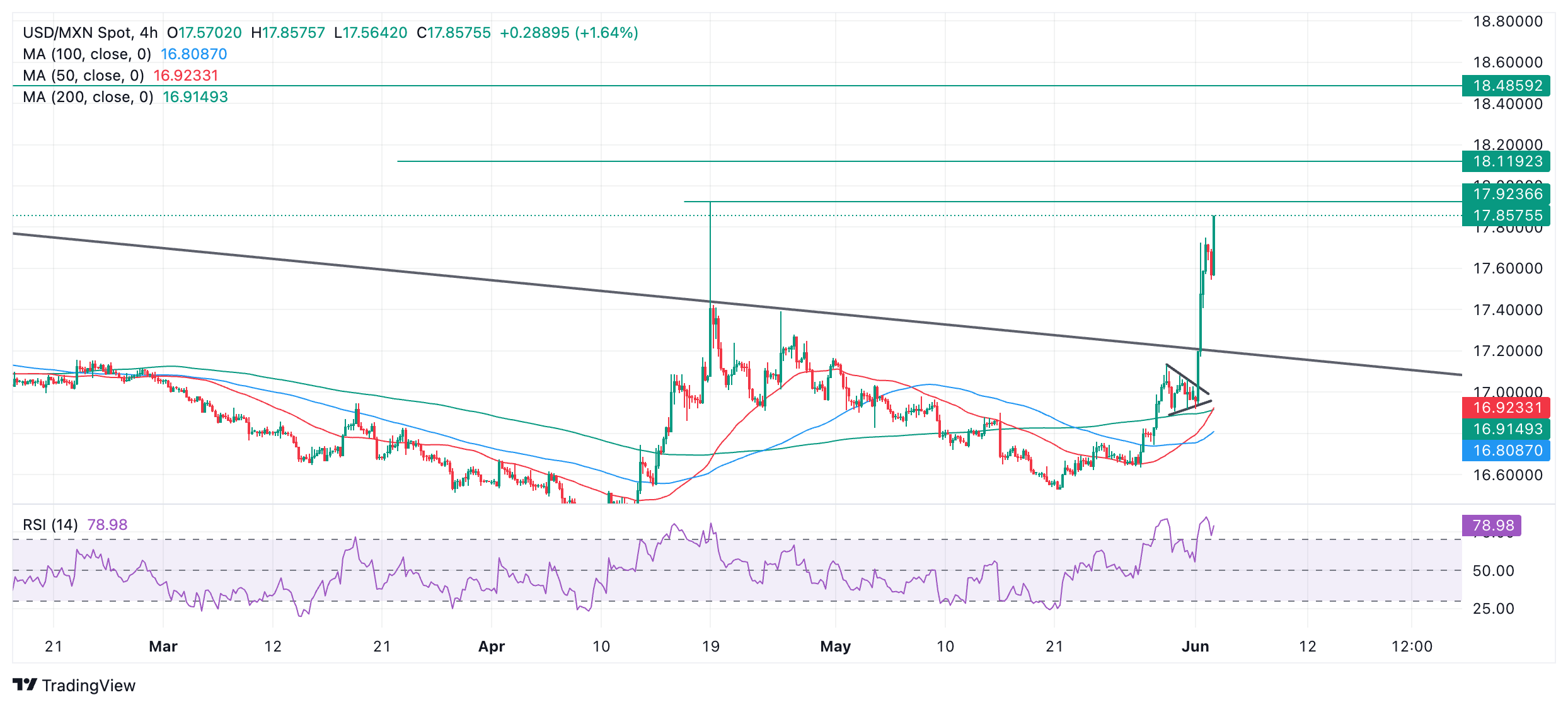The Mexican Peso pauses after plummeting over 4% in key pairs on Monday.
The possibility of the left-leaning Morena party winning a supermajority sparks fears among investors.
USD/MXN breaks above a key long-term trendline, transforming the technical picture for the pair.
The Mexican Peso (MXN) is resuming its downtrend after a brief pause on Tuesday following an over 4% decline in its key pairs on Monday. The Peso went into freefall after early indications showed President-elect Claudia Sheinbaum and her Morena party were heading for a landslide victory in the Mexican presidential and congressional elections held on Sunday.
USD/MXN is exchanging hands at 17.87 at the time of writing, EUR/MXN is trading at 19.47 and GBP/MXN at 22.86.
Mexican Peso weakens on fears of a Morena party supermajority
The Mexican Peso plummeted on Monday after a quick count by the National Electoral Institute showed Claudia Sheinbaum leading with at least 59% of the vote in the presidential elections, and her Morena party poised to possibly clinch super majorities in both houses of the Mexican legislature, according to Aljazeera News. The official results will be published after the votes are counted between June 5-8.
The Mexican Peso weakened significantly after investors became nervous Sheinbaum’s Morena party could win super majorities – defined as a majority of two thirds – in both the Congress and the Senate. This would enable them to enact proposed reforms to the Mexican constitution, such as the election of the judiciary by popular vote and the preferential treatment of state-owned energy companies over private corporations. Critics argue such changes could be anti-democratic and market unfriendly.
According to estimates by Bloomberg Economics, Morena will probably win a super majority in Congress but fall four-seats short of one in the Senate.
“Although that doesn’t immediately allow Sheinbaum to make changes to the constitution that have eluded [current President] Andres Manuel Lopez Obrador, it leaves her in the position to negotiate with just a few senators to pass key reforms,” said Bloomberg News’ Economy and Government reporter Alex Vasquez.
Yet not all of Sheinbaum’s policies will necessarily hurt the Mexican Peso. Her pledge to increase the minimum wage by around 11%, better welfare benefits and government-led investment could increase consumer spending and economic growth, forcing the Banco de México (Banxico) to maintain high interest rates, according to Kimberley Sperrfechter, Emerging Markets Economist at Capital Economics.
Since relatively high interest rates attract more foreign capital inflows, the Peso could remain well-supported despite investor fears.
Technical Analysis: USD/MXN breaks decisively above major trendline
USD/MXN – or the number of Pesos that can be bought with one US Dollar – breaks above a long-term trendline, marking a major shift in the outlook for the pair and probably reversing the intermediate-term downtrend to an uptrend.
With both the short and intermediate trends bullish, the odds favor more upside over those time frames (up to six months).
USD/MXN 4-hour Chart

Further upside could see USD/MXN reach the April highs at around 17.92, followed by resistance at 18.12 (100-week Simple Moving Average) and then 18.49 (October 2023 high).
The long-term trend is probably still bearish, however, suggesting a risk of a reversal lower if the uptrend runs out of steam. There are no signs of that happening yet from price action, however, which remains resolutely bullish.
Mexican Peso FAQs
The Mexican Peso (MXN) is the most traded currency among its Latin American peers. Its value is broadly determined by the performance of the Mexican economy, the country’s central bank’s policy, the amount of foreign investment in the country and even the levels of remittances sent by Mexicans who live abroad, particularly in the United States. Geopolitical trends can also move MXN: for example, the process of nearshoring – or the decision by some firms to relocate manufacturing capacity and supply chains closer to their home countries – is also seen as a catalyst for the Mexican currency as the country is considered a key manufacturing hub in the American continent. Another catalyst for MXN is Oil prices as Mexico is a key exporter of the commodity.
The main objective of Mexico’s central bank, also known as Banxico, is to maintain inflation at low and stable levels (at or close to its target of 3%, the midpoint in a tolerance band of between 2% and 4%). To this end, the bank sets an appropriate level of interest rates. When inflation is too high, Banxico will attempt to tame it by raising interest rates, making it more expensive for households and businesses to borrow money, thus cooling demand and the overall economy. Higher interest rates are generally positive for the Mexican Peso (MXN) as they lead to higher yields, making the country a more attractive place for investors. On the contrary, lower interest rates tend to weaken MXN.
Macroeconomic data releases are key to assess the state of the economy and can have an impact on the Mexican Peso (MXN) valuation. A strong Mexican economy, based on high economic growth, low unemployment and high confidence is good for MXN. Not only does it attract more foreign investment but it may encourage the Bank of Mexico (Banxico) to increase interest rates, particularly if this strength comes together with elevated inflation. However, if economic data is weak, MXN is likely to depreciate.
As an emerging-market currency, the Mexican Peso (MXN) tends to strive during risk-on periods, or when investors perceive that broader market risks are low and thus are eager to engage with investments that carry a higher risk. Conversely, MXN tends to weaken at times of market turbulence or economic uncertainty as investors tend to sell higher-risk assets and flee to the more-stable safe havens.
Information on these pages contains forward-looking statements that involve risks and uncertainties. Markets and instruments profiled on this page are for informational purposes only and should not in any way come across as a recommendation to buy or sell in these assets. You should do your own thorough research before making any investment decisions. FXStreet does not in any way guarantee that this information is free from mistakes, errors, or material misstatements. It also does not guarantee that this information is of a timely nature. Investing in Open Markets involves a great deal of risk, including the loss of all or a portion of your investment, as well as emotional distress. All risks, losses and costs associated with investing, including total loss of principal, are your responsibility. The views and opinions expressed in this article are those of the authors and do not necessarily reflect the official policy or position of FXStreet nor its advertisers. The author will not be held responsible for information that is found at the end of links posted on this page.
If not otherwise explicitly mentioned in the body of the article, at the time of writing, the author has no position in any stock mentioned in this article and no business relationship with any company mentioned. The author has not received compensation for writing this article, other than from FXStreet.
FXStreet and the author do not provide personalized recommendations. The author makes no representations as to the accuracy, completeness, or suitability of this information. FXStreet and the author will not be liable for any errors, omissions or any losses, injuries or damages arising from this information and its display or use. Errors and omissions excepted.
The author and FXStreet are not registered investment advisors and nothing in this article is intended to be investment advice.
>>> Read full article>>>
Copyright for syndicated content belongs to the linked Source : FXStreet – https://www.fxstreet.com/news/mexican-peso-falls-over-4-after-landslide-victory-for-left-202406040821














![[News] Japan Develops 10nm Nanoimprint Technology, with Potential to Tackle EUV Bottleneck – TrendForce](https://earth-news.info/wp-content/uploads/2025/12/329851-news-japan-develops-10nm-nanoimprint-technology-with-potential-to-tackle-euv-bottleneck-trendforce-360x180.jpg)
















